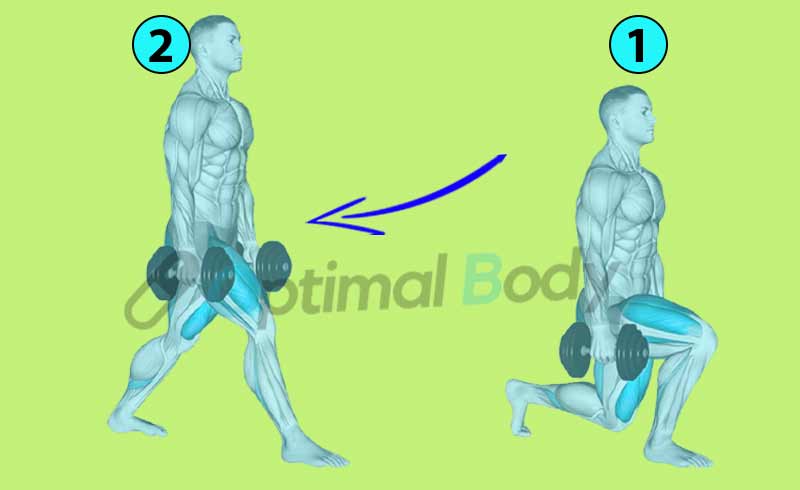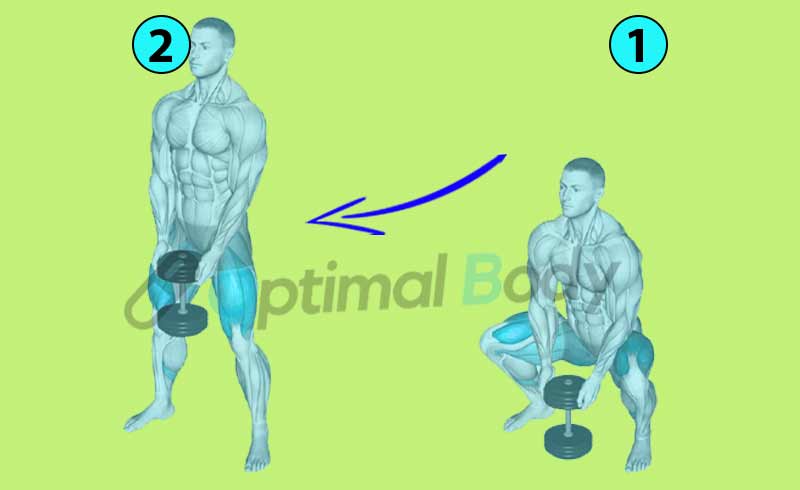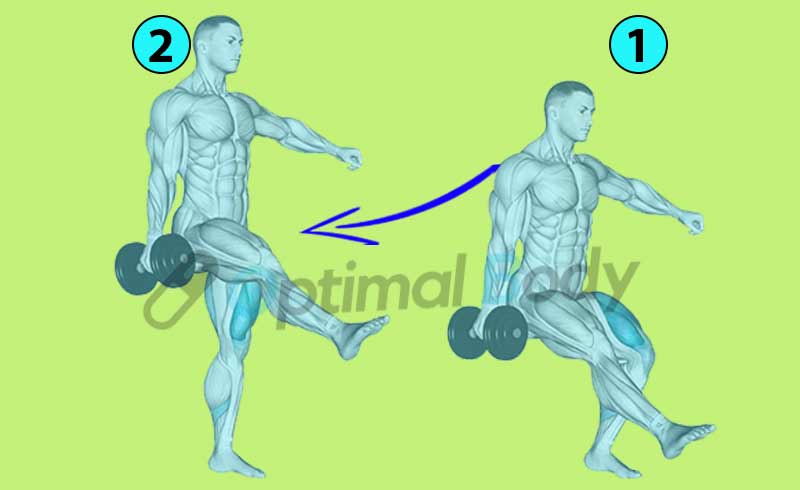While most folks prefer barbell squats, don’t overlook the dumbbell squat, it’s quite handy for leg day.
Plus, there are different types and dumbbell squat variations to try out.
Now, you might be tempted to try fancy ones like the front squat or split squat, but here’s a tip:
start with the basic dumbbell squat. Why?
Because getting really good at this one sets you up for better skills and makes your legs stronger.
So, What’s a Dumbbell Squat?
Dumbbell squats are a highly effective lower body exercise, targeting the quadriceps, glutes, hamstrings, and calves.
They increase the load on these muscles and engage core, ankle, and hip stabilizers for improved balance and overall strength development.
It’s a bit like other squats, you bend your hips and knees while your ankles move during the down part.
It’s mainly about working the muscles in your lower body, like your thighs and butt.
The cool thing about dumbbell squats is you can hold the weights in different ways. You can put them on your shoulders, hold them in front, keep them at your sides, or even hold them like a goblet.
Including dumbbell squat exercises in your workout routine is a valuable addition, promoting both general strength and muscle growth.
Dumbbell Squat Variations To Build Muscle And Strength
Here, we’ll explore two effective and easy-to-follow dumbbell squat variations:
1. Dumbbell Front Squat
The dumbbell front squat shifts the weight to the front of your body, offering a unique challenge and emphasizing your quadriceps.
Muscles Targeted:
This variation mainly targets your quadriceps but also engages your glutes, hamstrings, and core more intensely due to the upright position.
How to Do:

- Hold a dumbbell in each hand, bringing it to your chest, ensuring your upper back stays straight.
- Stand with your feet hip-width apart and toes pointing forward.
- Lower your body by bending your knees until you reach parallel or lower.
- Push through your heels to return to the starting position.
Benefits:
- Quadriceps Focus: If you want to put extra emphasis on your quadriceps, this is the squat for you.
- Spine-Friendly: It’s a safer option for your spine compared to some other squat variations.
2. Regular Dumbbell Squat
The dumbbell squat closely resembles a regular bodyweight or barbell squat but with a slight twist. It’s a perfect starting point for beginners or anyone looking to work their quads with added resistance.
Muscles Targeted:
The standard dumbbell squat primarily targets your quadriceps, glutes, and hamstrings.
Additionally, your core, erector spinae, and forearms come into play depending on how you hold the dumbbells.
How to do:

- Hold a dumbbell in each hand, either at shoulder height or by your sides.
- Stand with your feet slightly wider than hip-width apart, engage your core.
- Push your hips back and lower your body until your thighs are parallel to the ground or lower.
- Press through your heels to return to the starting position.
Benefits:
- Builds Foundation: This exercise is the foundation for more complex squat variations. It helps you develop the necessary skills and strength.
- Balanced Muscle Engagement: The dumbbell squat evenly works your lower body muscles while avoiding some of the drawbacks associated with other squat types.
3. Goblet Squat
The Goblet Squat combines elements of the sumo and conventional squat, emphasizing your quadriceps and core.
Muscles Targeted:
Goblet Squats work your quadriceps, glutes, hamstrings, and demand core stabilization.
How to Perform:

- Stand with your feet slightly wider than hip-width apart.
- Hold one end of a dumbbell with both hands at chest level, like you’re holding a goblet.
- Keep your core tight, spine neutral, and head facing forward.
- Push your hips back and bend your knees, lowering your body.
- Maintain the dumbbell’s position at chest level.
- When your thighs are parallel to the ground or lower, push through your heels to return to the starting position.
Benefits:
- Quad and Core Intensity: Focus on quads and core engagement while sparing your back.
- Strength and Mass: Build lower body strength and muscle mass effectively.
4. Offset Dumbbell Squat
The Dumbbell Offset Squat is a creative twist on traditional squats. Instead of holding a dumbbell or barbell with both hands, you hold a dumbbell with just one hand, creating an unbalanced load that challenges your body.
Muscles Targeted:
The dumbbell offset squat works your quadriceps, glutes, and hamstrings like regular squats. But it also engages your core, shoulders, and stabilizers, giving your whole body a thorough workout.
How to Do It:

- Hold a dumbbell in your left hand and place it on your left shoulder.
- Extend your right arm in front for balance.
- Squat as low as your flexibility allows, keeping your chest up and looking ahead.
- Return to the starting position.
- Switch to your right hand and repeat.
Benefits:
- Full-Body Engagement: It efficiently targets all muscle groups, from your lower body to upper body and core.
- Strength and Muscle: This exercise helps you build both strength and muscle size, improving muscle definition with regular practice.
5. The Dumbbell Split Squat
The dumbbell split squat is a single-leg squat that emphasizes your quadriceps while offering unique stability challenges.
Muscles Targeted:
Primarily targets your quadriceps, but also works the glutes, hamstrings, and calves to some extent.
How to Perform:

- Stand with one foot forward and the other extended behind you.
- Hold a dumbbell in each hand, by your sides or in the front rack position.
- Lower your body by bending both knees until the front thigh is parallel to the floor.
- Return to the starting position.
Benefits:
- Unilateral Training: Strengthens each leg individually, addressing imbalances.
- Functional Fitness: Replicates real-world movements, making it a favorite among athletes.
6. Sumo Dumbbell Squat
The dumbbell sumo squat is just like a regular dumbbell squat, but with a twist, which is a wider stance.
This wider stance puts more focus on your backside muscles and reduces the range of motion, making it a unique and beneficial variation.
Muscles Targeted:
The primary targets are your glutes and hamstrings. It also engages your lower back muscles more than other squat variations.
How to Perform:

- Begin by standing with your feet positioned wide apart, and point your toes slightly outward.
- Hold a dumbbell in a goblet position (both hands holding one end of the dumbbell).
- Maintain an engaged core and an upright chest.
- Push your hips back and bend your knees until your hips are just above knee level.
- Return to the standing position.
Benefits:
- Boosts Posterior Chain: The wide stance enhances development in your posterior chain (backside muscles).
- Lift Heavier: The reduced range of motion allows you to lift more weight with each repetition.
7. Dumbbell Squat Press
The dumbbell squat press is a full-body exercise that combines two fundamental movements: the squat and the shoulder press.
How To Do It:

- Grab a dumbbell in each hand.
- Stand with your feet about shoulder-width apart.
- Hold the dumbbells at shoulder level, keeping your elbows bent.
- Lower your body down into a squat by bending your knees and pushing your hips back.
- Keep your back straight and your head up as you squat down.
- Push through your heels to stand back up, simultaneously pressing the dumbbells overhead.
- Lower the dumbbells back down to shoulder level.
- Repeat the squat press motion.
Benefits:
- Works multiple muscle groups: This exercise targets your back, thighs, buttocks, and hamstrings all at once.
- Strengthens your core: It also helps build a strong midsection, which can enhance stability and support other exercises.
- Increases range of motion: Regular practice can improve your overall flexibility and mobility.
8. Dumbbell Single Leg Squat
The Dumbbell Single Leg Squat is an effective lower body exercise that challenges your leg strength and stability.
It involves holding a dumbbell in one hand while standing on one leg and performing a squat motion.
Muscles Worked
Quadriceps, Glutes, Hamstrings, Calves, Core
How To Do:

- Stand with feet shoulder-width apart, holding a dumbbell in one hand.
- Lift the opposite foot off the ground, finding balance on one leg.
- Keep your back straight and engage your core.
- Bend the supporting knee to squat as low as possible.
- Pause briefly, feeling the stretch and engagement in your working leg.
- Push through the supporting foot to return to the starting position.
- Switch sides and repeat.
Benefits:
- Balance: It makes your body better at staying steady on one leg.
- Stability: It helps you become more secure and less likely to wobble.
- Leg Strength: It makes your leg muscles, like your thighs, stronger.
Squat Exercises With Dumbbells Training Plan
When it comes to dumbbell squat exercises, there are several important things to keep in mind to get the most out of your workout.
Whether you’re a beginner or an experienced lifter, these tips and guidelines will help you target different muscle groups.
Variety is Key
Squat variations are excellent for working various parts of your legs and glutes. Just like the tricep has three heads, the legs and glutes have different muscles too.
So, it’s important to mix things up to shape and define your lower body effectively.
Sets and Reps
The number of sets and repetitions you do can make a big difference in your results. Here’s a simple breakdown:
- For building strength: Aim for 3-5 sets of 6-10 reps with heavier weights.
- For muscle endurance: Go for 3-4 sets of 12-15 reps with a moderate weight.
- For muscle growth (hypertrophy): Target 3-4 sets of 8-12 reps with moderate to heavy weights.
As you progress and get stronger, you can adjust these numbers to challenge yourself.
Incorporate Into Your Quad Routine
There are different ways to include dumbbell squat variations in your workouts:
- As a Standalone Exercise: Do 3-4 sets of your chosen squat variation with 8-12 reps each. This is great for targeting your legs and glutes directly.
- As Part of a Leg Workout: Combine squats with other leg exercises like lunges, leg presses, or calf raises to create a well-rounded leg day routine.
- In a Full-Body Workout: If you prefer full-body workouts, incorporate squats into your routine alongside exercises like deadlifts, bench presses, and rows for a comprehensive workout.
Here’s a weekly leg-focused workout routine that incorporates the mentioned dumbbell squat variations along with other leg exercises.
This split routine allows you to target different aspects of your leg muscles throughout the week for a well-rounded lower body workout.
Quadriceps Focus
- Dumbbell Front Squat:
- Sets: 3
- Reps: 10-12
- Leg Press Machine:
- Sets: 3
- Reps: 8-10
- Lunges:
- Sets: 3 (each leg)
- Reps: 12-15 (each leg)
Hamstrings and Glutes Focus
- Regular Dumbbell Squat:
- Sets: 3
- Reps: 8-10
- Romanian Deadlifts (with dumbbells):
- Sets: 3
- Reps: 10-12
- Glute Bridges:
- Sets: 3
- Reps: 12-15
Full Leg Workout
- Goblet Squat:
- Sets: 3
- Reps: 12-15
- Leg Extension Machine:
- Sets: 3
- Reps: 10-12
- Step-Ups (using a bench or sturdy platform):
- Sets: 3 (each leg)
- Reps: 10-12 (each leg)
Glutes and Hamstrings Focus
- Sumo Dumbbell Squat:
- Sets: 3
- Reps: 10-12
- Dumbbell Deadlifts:
- Sets: 3
- Reps: 8-10
- Hip Thrusts:
- Sets: 3
- Reps: 12-15
Compound Leg Workout
- Dumbbell Squat Press:
- Sets: 3
- Reps: 8-10
- Dumbbell Lunges:
- Sets: 3 (each leg)
- Reps: 10-12 (each leg)
- Calf Raises (with dumbbells):
- Sets: 3
- Reps: 15-20
Conclusion Which Dumbbell Squat Variation Should You Choose?
There isn’t a single perfect dumbbell squat variation that suits everyone. Each squat variation serves a specific purpose in a workout routine, emphasizing that not all squats are created equal.
However, the regular dumbbell squat is recommended for beginners because it helps build a strong foundation for squatting technique and strength development.
As you gain confidence and master the basics, you are encouraged to explore more advanced squat variations that align with your specific fitness goals.
References:
- Illmeier, G.; Rechberger, J.S. The Limitations of Anterior Knee Displacement during Different Barbell Squat Techniques: A Comprehensive Review. J. Clin. Med. 2023, 12, 2955. https://doi.org/10.3390/jcm12082955
- Robert Wood, “Dumbbell Squat Exercise.” Topend Sports Website, October 2010, https://www.topendsports.com/fitness/technique/squats-dumbbell.htm, Accessed 21 September 2023
- Erdağ, Deniz & Yavuz, Hasan. (2020). Evaluation of Muscle Activities During Different Squat Variations Using Electromyography Signals. 10.1007/978-3-030-35249-3_114.
- Cohen, J. W., Lee, P., & Buchman-Pearle, J. (2017). The Effects of Footwear on Squat Movements. Western Undergraduate Research Journal: Health and Natural Sciences, 8(1). https://doi.org/10.5206/wurjhns.2017-18.29
- Bench Press Calculator - April 22, 2024
- Press to Handstand: Ultimate Step-by-Step Guide - April 22, 2024
- Cable Press (How To Do, Benefits, Targeted Muscles, Alternative) - April 22, 2024
